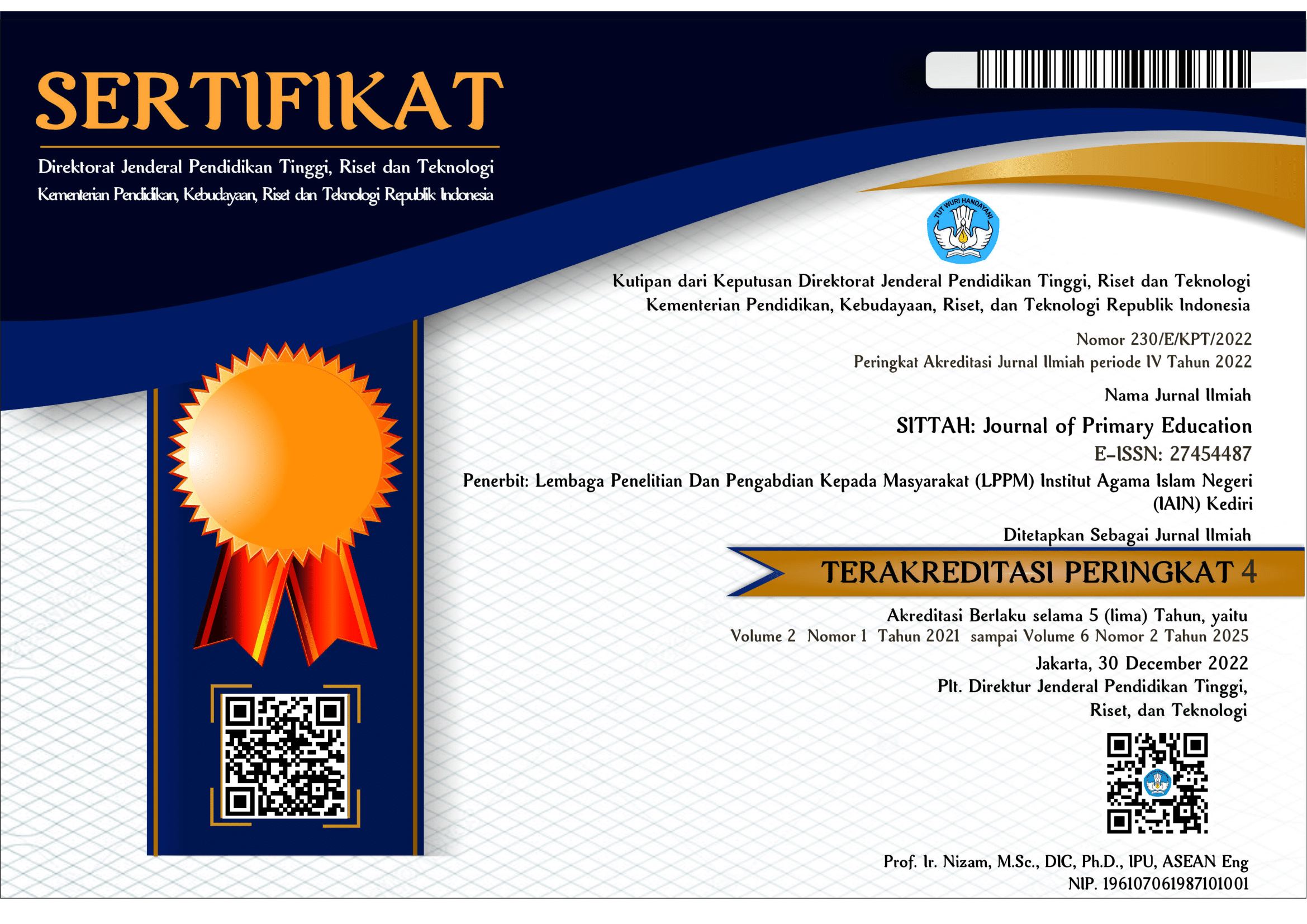LEARNING TRAJECTORY KONSEP NILAI TEMPAT TIGA ANGKA
DOI:
https://doi.org/10.30762/sittah.v3i1.2Keywords:
Hypothetical Learning Trajectory, Lesson Design, Place Value ConceptAbstract
Learning place values from 2 digits to multi-digit requires various forms of representation. The representation will bring up a variety of Hypothetical Learning Trajectory (HLT) in the form of predictions of possible student responses, which will later produce the actual student learning trajectory. This study aims to find students' learning trajectory patterns and determine the factors that influence students' learning trajectory patterns in the 3-digit place value material. The research design uses qualitative research. The learning trajectory pattern was obtained through analysing student responses in the field based on the previously designed HLT. The subjects of this study were 50 students of grade II from three elementary schools in the Kebumen Regency. The research instrument is a written test and field notes. The written test contains four place value questions with a horizontal representation strategy. Field notes in the form of student responses by watching videos during the application of lesson design accompanied by making transcripts to further clarify the word for word that comes out as a form of response during learning so that the suitability of the response with HLT can be known. The results of this study indicate that the student's learning trajectory pattern takes place through the application of a didactic design consisting of 4 types of lesson designs that place the number 0 in different positions. The application of didactic design can also direct students to learn independently gradually. Meanwhile, the learning trajectory supporting factors consist of students' prerequisite abilities, planning and learning processes, and the use of learning resources.
Downloads
References
Astuti, I. M. J. (2017). Tema 1 Hidup Rukun Buku Tematik Terpadu Kurikulum 2013: Buku Guru SD/MI Kelas II. Pusat Kurikulum dan Perbukuan Kemendikbud.
Bednarz, N., & Janvier, B. (1988). A constructivist approach to numeration in primary school: Results of a three year intervention with the same group of children. Educational Studies in Mathematics, 19(3), 299–331. https://doi.org/10.1007/BF00312450
Brown, C. S., Sarama, J., & Clements, D. H. (2007). Thinking about Learning Trajectories in Preschool. Teaching Children Mathematics, 14(3), 178–181.
Bruner, J. S. (1977). The Process of Education: First Edition. Harvard University Press.
Bussi, B., & G, M. (2011). Artefacts and Utilization Schemes in Mathematics Teacher Education: Place Value in Early Childhood Education. Journal of Mathematics Teacher Education, 14(2), 93–112. https://doi.org/10.1007/s10857-011-9171-2
Chandler, C. C., & Kamii, C. (2009). Giving Change When Payment Is Made With a Dime: The Difficulty of Tens and Ones. Journal for Research in Mathematics Education, 40(2), 97–118. https://doi.org/10.2307/40539328
Clements, D. H., & Sarama, J. (2004). Learning trajectories in mathematics education. Mathematical Thinking and Learning, 6(2), 81–89. https://doi.org/10.1207/s15327833mtl0602_1
Dahar, R. W. (2011). Teori-teori Belajar dan Pembelajaran. Erlangga.
Daro, P., Mosher, F. A., & Corcoran, T. (2011). Learning Trajectories in Mathematics: A Foundation for Standards, Curriculum, Assessment, and Instruction. CPRE Research Report # RR-68. In Consortium for Policy Research in Education. Consortium for Policy Research in Education. https://eric.ed.gov/?id=ED519792
Dedy, E., & Sumiaty, E. (2017). Desain Didaktis Bahan Ajar Matematika SMP Berbasis Learning Obstacle dan Learning Trajectory. JRPM (Jurnal Review Pembelajaran Matematika), 2(1), 69–80. https://doi.org/10.15642/jrpm.2017.2.1.69-80
Fitriani, N., Kadarisma, G., & Amelia, R. (2020). Pengembangan Desain Didaktis untuk Mengatasi Learning Obstacle pada Materi Dimensi Tiga. AKSIOMA: Jurnal Program Studi Pendidikan Matematika, 9(2), 231–241. https://doi.org/10.24127/ajpm.v9i2.2686
Fuson, K. C. (1986). Roles of representation and verbalization in the teaching of multi-digit addition and subtraction. European Journal of Psychology of Education, 1(2), 35–56. https://doi.org/10.1007/BF03172568
Fuson, K. C., & Briars, D. J. (1990). Using a base-ten blocks learning/teaching approach for first- and second-grade place-value and multidigit addition and subtraction. Journal for Research in Mathematics Education, 21(3), 180–206. https://doi.org/10.2307/749373
Hendrifiana, Y., Ariguntar, P., & Assagaf, L. (2017). Diriku: Buku tematik terpadu kurikulum 13 buku guru SD/MI Kelas I (L. Chamisijatin, H. S. Prabawanto, N. W. Rochmadi, F. N. Utorodewo, T. H. Retnowati, M. Mulyana, L. Purnastuti, H. Setyawati, Y. Mulyati, H. A. Sastromiharjo, R. Al-Atok, S. Sugiarto, E. Yetti, S. Suharji, W. Pekerti, R. Milyartini, & B. Prihadi, Eds.). Pusat Kurikulum dan Perbukuan, Badan Penelitian dan Pengembangan, Kementrian Pendidikan dan Kebudayaan. http://repositori.kemdikbud.go.id/6895/
Heruman. (2007). Model Pembelajaran Matematika di SD. Remaja Rosdakarya.
Hidayati, E. W. (2018). Penggunaan Media Puzzle Konstruksi Terhadap Hasil Belajar Kognitif Siswa SDN Kemangsen II Krian. Indonesian Journal of Islamic Education Studies (IJIES), 1(1), 61–88. https://doi.org/10.33367/ijies.v1i1.519
Hiebert, J., & Wearne, D. (1992). Links between teaching and learning place value with understanding in first grade. Journal for Research in Mathematics Education, 23(2), 98–122. https://doi.org/10.2307/749496
Hiebert, J., & Wearne, D. (1996). Instruction, Understanding, and Skill in Multidigit Addition and Subtraction. Cognition and Instruction, 14(3), 251–283. https://doi.org/10.1207/s1532690xci1403_1
Kamii, C., & Joseph, L. L. (1989). Young Children Continue to Reinvent Arithmetic--2nd Grade: Implications of Piaget’s Theory. Teachers College Press.
Mix, K. S., Prather, R. W., Smith, L. B., & Stockton, J. D. (2014). Young children’s interpretation of multidigit number names: From emerging competence to mastery. Child Development, 85(3), 1306–1319. https://doi.org/10.1111/cdev.12197
Prabawanto, S., & Rahayu, P. (2006). Bilangan. UPI Press.
Putra, N. (2012). Metode Penelitan Kualitatif Pendidikan. PT. RajaGrafindo Persada.
Putri, D. P., Manfaat, B., & Haqq, A. A. (2020). Desain didaktis pembelajaran matematika untuk mengatasi hambatan belajar pada materi matriks. Jurnal Analisa, 6(1), 56–68. https://doi.org/10.15575/ja.v6i1.5694
Rezky, R. (2019). Hypothetical Learning Trajectory (HLT) dalam Perspektif Psikologi Belajar Matematika. Ekspose: Jurnal Penelitian Hukum dan Pendidikan, 18(1), 762–769. https://doi.org/10.30863/ekspose.v18i1.364
Ross, S. H. (1986). The Development of Children’s Place-Value Numeration Concepts in Grades Two through Five. https://eric.ed.gov/?id=ED273482
Simanjuntak, L. (1992). Metode Mengajar Matematika. Rineka cipta.
Simon, M. A., & Tzur, R. (2004). Explicating the Role of Mathematical Tasks in Conceptual Learning: An Elaboration of the Hypothetical Learning Trajectory. Mathematical Thinking and Learning, 6(2), 91–104. https://doi.org/10.1207/s15327833mtl0602_2
Sitepu, B. P. (2014). Pengembangan Sumber Belajar. PT. RajaGrafindo Persada.
Thalhah, S. Z. (2018). Profil Kemampuan Mahasiswa Tadris Matematika dalam Memecahkan Masalah Program Linear Ditinjau dari Perbedaan Tingkat Kemampuan Prasyarat dan Gaya Kognitif Fiel Dependent. Al-Khwarizmi : Jurnal Pendidikan Matematika dan Ilmu Pengetahuan Alam, 6(1), 29–46. https://doi.org/10.24256/jpmipa.v6i1.397
Thompson, I. (2000). Teaching Place Value in the UK: Time for a reappraisal? Educational Review, 52(3), 291–298. https://doi.org/10.1080/713664046
Unaenah, E., & Sumantri, M. S. (2019). Analisis Pemahaman Konsep Matematis Siswa Kelas 5 Sekolah Dasar pada Materi Pecahan. Jurnal Basicedu, 3(1), 106–111. https://doi.org/10.31004/basicedu.v3i1.85
Walle, J. A. V. D. (2007). Matematika Sekolah Dasar dan Menengah (Suryono, Trans.). Erlangga.
Downloads
Published
How to Cite
Issue
Section
License
Copyright (c) 2022 Ulsana Puji Lestari

This work is licensed under a Creative Commons Attribution-NonCommercial-ShareAlike 4.0 International License.











